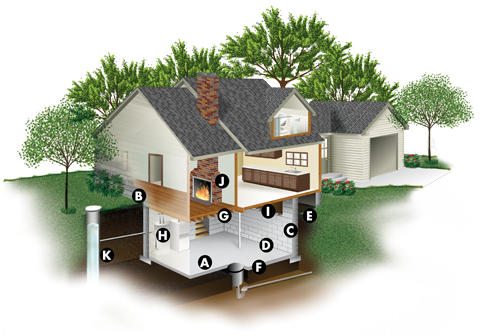
Effective January 1, 2014 the new Radon Awareness Act became effective. This new Minnesota state law requires a seller of residential property to disclose in writing to the buyer any knowledge the seller has of radon concentrations in the home.
All real estate transactions in Minnesota must add one more disclosure to the list – a radon test and results must be performed. Under the Minnesota Radon Awareness Act, a new law pushed through the 2013 Legislature, disclosure of a test for the existence of radon and results must be available. Sellers who do a radon test, and the test reveals the existence of radon, must also disclose possible remedies.
Radon in Minnesota Homes
The Minnesota Department of Health (MDH) provides information on radon and how to protect your family’s health. MDH also recommends that every Minnesota home be tested for radon.
Download a printable version of the brochure “Radon: Keeping Your Home Safe” (PDF:793KB/15 pages)
What is radon?
Radon is a colorless, odorless radioactive gas that seeps up from the earth. When inhaled, it gives off radioactive particles that can damage the cells that line the lung.
Long term exposure to radon can lead to lung cancer. In fact, over 21,000 lung cancer deaths in the US each year are from radon, making it a serious health concern for all Minnesotans.
Where does radon come from?
The soil. Radon is produced from the natural decay of uranium that is found in nearly all soils. Uranium breaks down to radium. As radium disintegrates it turns into radioactive gas…radon. As a gas, radon moves up through the soil and into the air you breathe.
How dangerous is radon?
Radon is the number one cause of lung cancer in non-smokers and the second leading cause of lung cancer (after tobacco) in smokers. Thankfully, this risk should be entirely preventable through awareness and testing.
Where is your greatest exposure to radon?
While radon is present everywhere, and there is no known, safe level, your greatest exposure is where it can concentrate-indoors. And where you spend most time-at home. Your home can have radon whether it be old or new, well-sealed or drafty, and with or without a basement.
How serious a problem is radon in Minnesota?
High radon exist in every state in the US. In Minnesota, 2 in 5 homes has radon levels that pose a significant health risk, and nearly 80% of counties are rated high radon zones. Some factors that further contribute to Minnesota’s high radon levels include:
- Minnesota’s geology produces an ongoing supply of radon.
- Minnesota’s climate affects how our homes are built and operate.
How does radon enter a home?
Since radon is produced from soil, it is present nearly everywhere. Because soil is porous radon gas is able to move up through the dirt and rocks and into the air we breathe. If allowed to accumulate, radon becomes a health concern.
Two components that affect how much radon will accumulate in a home are pathways and air pressure. These components will differ from home to home.
- Pathways are routes the gas uses to enter your home and found anywhere there is an opening between the home and the soil.
- Air pressure between your home’s interior and the exterior soil is what helps to draw radon gas into the home via pathways.
Radon’s Pathways into your home

A. Cracks in concrete slabs
B. Spaces behind brick veneer walls that rest on uncapped hollow-block foundations
C. Pores and cracks in concrete blocks
D. Floor-wall joints
E. Exposed soil, as in a sump or crawl space
F. Weeping (drain) tile, if drained to an open sump
G. Mortar joints
H. Loose fitting pipe penetrations
I. Open tops of block walls
J. Building materials: brick, concrete, rock
K. Well water (not commonly a major source in Minnesota homes)
For more information about protecting your home from Radon, please visit the MN Department of Health web site at http://www.health.state.mn.us/divs/eh/indoorair/radon/.


